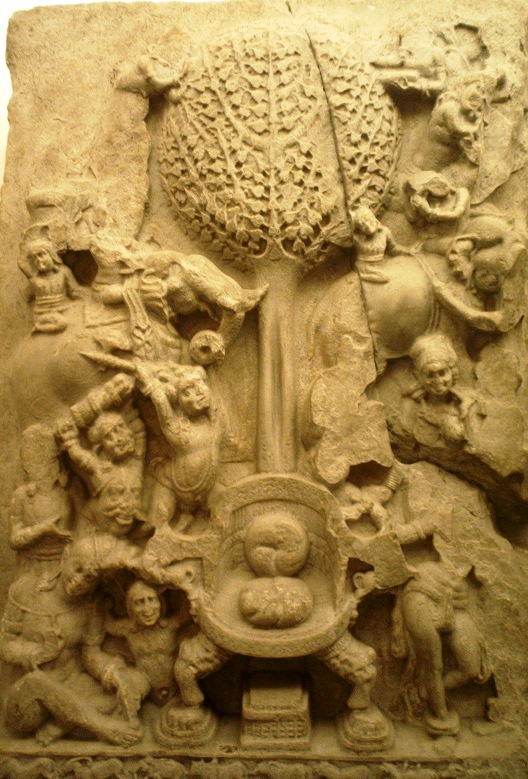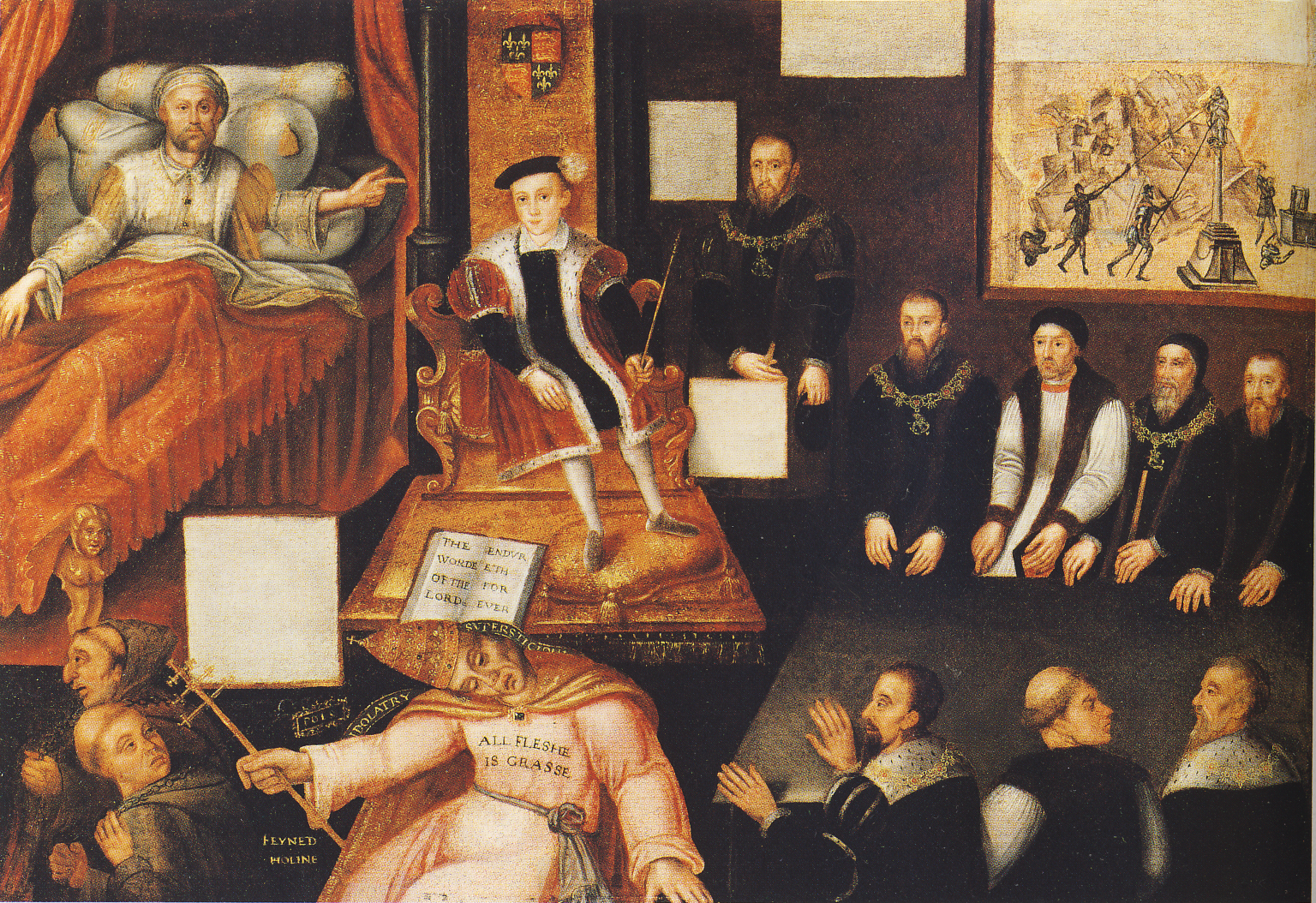|
Nottingham Alabaster
Nottingham alabaster is a term used to refer to the English sculpture industry, mostly of relatively small religious carvings, which flourished from the fourteenth century until the early sixteenth century. Alabaster carvers were at work in London, York and Burton-on-Trent, and many probably worked very close to the rural mines, but the largest concentration was around Nottingham. This has led to all the English medieval output being referred to as "Nottingham alabaster". Alabaster, a mineral composed of gypsum and various impurities, is much softer and easier to work than marble and a good material for mass production, though not suitable for outdoor use. Carvings were made as single figures, assemblies for tomb monuments, including full length effigies, but the most common survivals are panels, up to about 20 inches or 50 cm high, from sets for altarpieces, which could be transported relatively easily, and fitted into a locally made architectural surround of stone or wood ... [...More Info...] [...Related Items...] OR: [Wikipedia] [Google] [Baidu] |
English - Resurrection - Walters 27308
English usually refers to: * English language * English people English may also refer to: Culture, language and peoples * ''English'', an adjective for something of, from, or related to England England is a Countries of the United Kingdom, country that is part of the United Kingdom. It is located on the island of Great Britain, of which it covers about 62%, and List of islands of England, more than 100 smaller adjacent islands. It ... * ''English'', an Amish term for non-Amish, regardless of ethnicity * English studies, the study of English language and literature Media * English (2013 film), ''English'' (2013 film), a Malayalam-language film * English (novel), ''English'' (novel), a Chinese book by Wang Gang ** English (2018 film), ''English'' (2018 film), a Chinese adaptation * The English (TV series), ''The English'' (TV series), a 2022 Western-genre miniseries * English (play), ''English'' (play), a 2022 play by Sanaz Toossi People and fictio ... [...More Info...] [...Related Items...] OR: [Wikipedia] [Google] [Baidu] |
St George's Chapel At Windsor Castle
St George's Chapel, formally titled The King's Free Chapel of the College of St George, Windsor Castle, at Windsor Castle in England is a castle chapel built in the late-medieval Perpendicular Gothic style. It is a Royal peculiar, Royal Peculiar (a church under the direct jurisdiction of the monarch), and the Chapel of the Order of the Garter. St George's Chapel was founded in the 14th century by Edward III of England, King Edward III and extensively enlarged in the late 15th century. It is located in the Bailey (castle), Lower Ward of the castle. The castle has belonged to the monarchy for almost 1,000 years. The chapel has been the scene of many royal services, weddings and burials – in the 19th century, St George's Chapel and the nearby Frogmore, Frogmore Gardens superseded Westminster Abbey as the chosen burial place for the British royal family. The running of the chapel is the responsibility of the dean and Canons of Windsor who make up the Collegiate church, College of ... [...More Info...] [...Related Items...] OR: [Wikipedia] [Google] [Baidu] |
Nailloux Altarpiece
The Nailloux Altarpiece (French: "''Retable de Nailloux''") embodies the artistic style of France during the medieval era. The Nailloux consisted of five alabaster panels carved in high relief, this retable was made in dedication to the Passion of Jesus Christ. It is currently conserved in a chapel of St Martin's Church in Nailloux, in the Haute-Garonne department in southwestern France. The retable is a typical product of the Nottingham alabaster industry. This piece was carved during the second half of the 15th century, at a Midlands workshop in England. These were cheaper than alternative forms of sculpted altarpiece, and many of this kind were exported. The work was produced in a period of economic development for the region: the golden age of woad culture in Lauragais. With a total length of 1.46 m (57 in), the altarpiece is made of four side panels of 43 × 25 cm (18 x 9 in) and a bigger central panel of 50 × 25 cm (19 x 9 in). The Passion of Christ is the most common s ... [...More Info...] [...Related Items...] OR: [Wikipedia] [Google] [Baidu] |
Triptych
A triptych ( ) is a work of art (usually a panel painting) that is divided into three sections, or three carved panels that are hinged together and can be folded shut or displayed open. It is therefore a type of polyptych, the term for all multi-panel works. The middle panel is typically the largest and it is flanked by two smaller related works, although there are triptychs of equal-sized panels. The form can also be used for pendant jewelry. Beyond its association with art, the term is sometimes used more generally to connote anything with three parts, particularly if integrated into a single unit. Etymology The word ''triptych'' was formed in English by compounding the prefix '' tri-'' with the word '' diptych''. ''Diptych'' is borrowed from the Latin , which itself is derived from the Late Greek () . is the neuter plural of () . In art The triptych form appears in early Christian art, and was a popular standard format for altar paintings from the Middle Ages onwa ... [...More Info...] [...Related Items...] OR: [Wikipedia] [Google] [Baidu] |
Altarpiece
An altarpiece is a painting or sculpture, including relief, of religious subject matter made for placing at the back of or behind the altar of a Christian church. Though most commonly used for a single work of art such as a painting or sculpture, or a set of them, the word can also be used of the whole ensemble behind an altar, otherwise known as a reredos, including what is often an elaborate frame for the central image or images. Altarpieces were one of the most important products of Christian art especially from the late Middle Ages to the era of Baroque painting. The word altarpiece, used for paintings, usually means a framed work of panel painting on wood, or later on canvas. In the Middle Ages they were generally the largest genre for these formats. Murals in fresco tend to cover larger surfaces. The largest painted altarpieces developed complicated structures, especially winged altarpieces with hinged side wings that folded in to cover the main image, and were painted o ... [...More Info...] [...Related Items...] OR: [Wikipedia] [Google] [Baidu] |
High Relief
High may refer to: Science and technology * Height * High (atmospheric), a high-pressure area * High (computability), a quality of a Turing degree, in computability theory * High (tectonics), in geology an area where relative tectonic uplift took or takes place * Substance intoxication, also known by the slang description "being high" * Sugar high, a misconception about the supposed psychological effects of sucrose Music Performers * High (musical group), a 1974–1990 Indian rock group * The High, an English rock band formed in 1989 Albums * ''High'' (The Blue Nile album) or the title song, 2004 * ''High'' (Flotsam and Jetsam album), 1997 * ''High'' (New Model Army album) or the title song, 2007 * ''High'' (Royal Headache album) or the title song, 2015 * ''High'' (Keith Urban album), 2024 * ''High'' (EP), by Jarryd James, or the title song, 2016 Songs * "High" (Alison Wonderland song), 2018 * "High" (The Chainsmokers song), 2022 * "High" (The Cure song), 1992 * " ... [...More Info...] [...Related Items...] OR: [Wikipedia] [Google] [Baidu] |
Low Countries
The Low Countries (; ), historically also known as the Netherlands (), is a coastal lowland region in Northwestern Europe forming the lower Drainage basin, basin of the Rhine–Meuse–Scheldt delta and consisting today of the three modern "Benelux" countries: Belgium, Luxembourg, and the Netherlands (, which is singular). Geographically and historically, the area can also include parts of France (such as Nord (French department), Nord and Pas-de-Calais) and the Germany, German regions of East Frisia, Geldern, Guelders and Cleves. During the Middle Ages, the Low Countries were divided into numerous semi-independent principalities. Historically, the regions without access to the sea linked themselves politically and economically to those with access to form various unions of ports and hinterland, stretching inland as far as parts of the German Rhineland. Because of this, nowadays not only physically low-altitude areas, but also some hilly or elevated regions are considered part of ... [...More Info...] [...Related Items...] OR: [Wikipedia] [Google] [Baidu] |
Aniconism
Aniconism is the cultural absence of artistic representations ('' icons'') of the natural and supernatural worlds, or it is the absence of representations of certain figures in religions. The prohibition of material representations may only extend to a specific supreme deity, or it can encompass an entire pantheon, it can also include depictions of a prophet, saints, or sages, or even depictions of living beings and anything in existence generally. It is generally codified by religious traditions and as such, it becomes a taboo. When it is enforced by the physical destruction of images, aniconism becomes iconoclasm. Aniconism has historical phases in both Buddhism and Christianity, though these movements have been largely rejected as Buddha in art, life of Buddha in art, Buddhas and bodhisattvas in art, God the Father in Western art, Holy Spirit in Christian art, the depiction of Jesus, The Trinity in art, and are common. By contrast Aniconism in Islam, Islam has predomin ... [...More Info...] [...Related Items...] OR: [Wikipedia] [Google] [Baidu] |
Putting Away Of Books And Images Act 1549
The Putting away of Books and Images Act 1549 ( 3 & 4 Edw. 6. c. 10) was an act of the Parliament of England. The preamble of the act recites: It then proceeds to order the abolishing of all other religious books, as they tend to superstition and idolatry; and commands all persons to deface and destroy images of all kinds that were erected for religious worship, under a penalty for any to prevent the same. The act concludes, however, with a clause emphasising that its provisions do not extend to the effigies on tomb monuments: The act also stipulates that the people might still keep the primers set forth by the late king Henry VIII provided they erase the sentences of invocation, and names of popish saints. The act was repealed by Mary I, but James I re-established it. See also * Iconoclasm Iconoclasm ()From . ''Iconoclasm'' may also be considered as a back-formation from ''iconoclast'' (Greek: εἰκοκλάστης). The corresponding Greek word for i ... [...More Info...] [...Related Items...] OR: [Wikipedia] [Google] [Baidu] |
King Edward VI
Edward VI (12 October 1537 – 6 July 1553) was King of England and King of Ireland, Ireland from 28 January 1547 until his death in 1553. He was crowned on 20 February 1547 at the age of nine. The only surviving son of Henry VIII by his third wife, Jane Seymour, Edward was the first English monarch to be raised as a Protestant. During his reign, the realm was governed by a regency council because Edward never reached maturity. The council was first led by his uncle Edward Seymour, Duke of Somerset (1547–1549), and then by John Dudley, Duke of Northumberland (1550–1553). Edward's reign was marked by many economic problems and social unrest that in 1549 erupted into riot and rebellion. An expensive Rough Wooing, war with Kingdom of Scotland, Scotland, at first successful, ended with military withdrawal from Scotland and Boulogne-sur-Mer in exchange for peace. The transformation of the Church of England into a recognisably Protestant body also occurred under Edward, who too ... [...More Info...] [...Related Items...] OR: [Wikipedia] [Google] [Baidu] |







